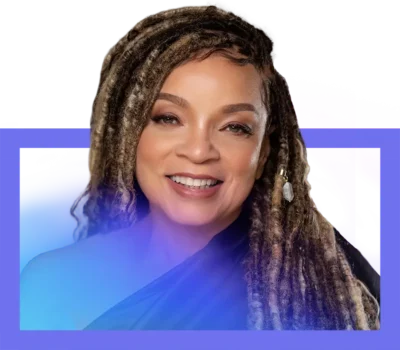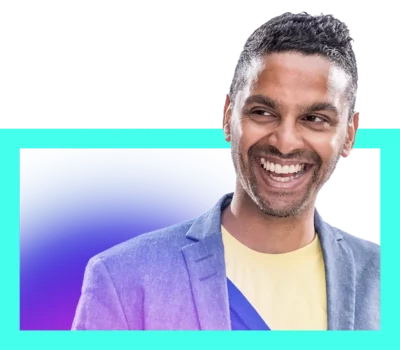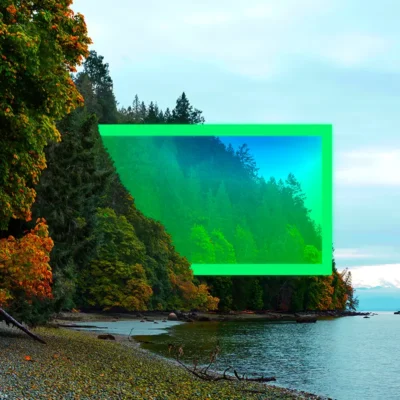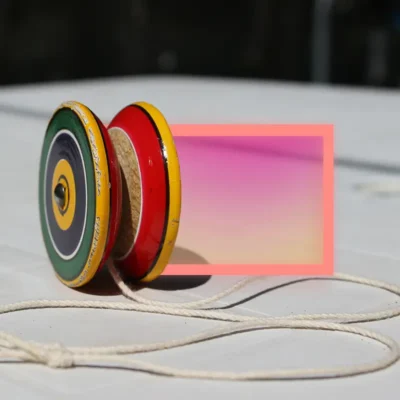Recognize the healing powers of your gifts
Academy Award-winning costume designer Ruth E. Carter has long been able to tap into her unique gifts as an artist to create beauty. In today’s episode, she shares how she learned to use her gifts to create opportunities for healing as well, especially when mourning the loss of her friend and colleague Chadwick Boseman.
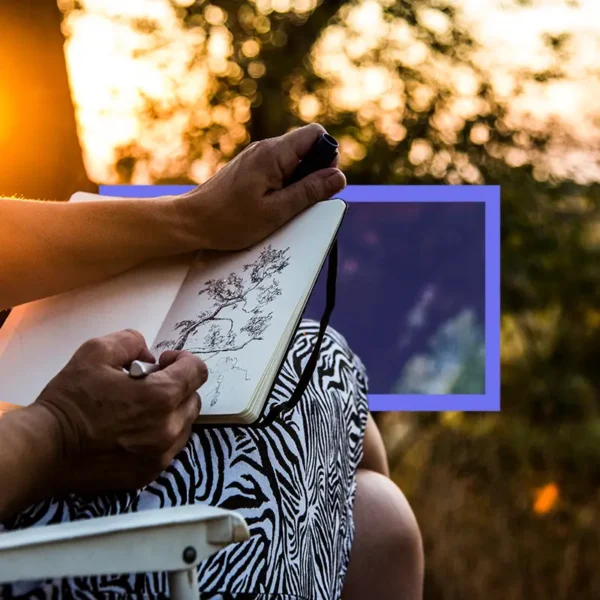

Table of Contents:
Transcript:
Recognize the healing powers of your gifts
RUTH E. CARTER: As I drive, I experience sensations of what life must have felt like long ago, long before my mother’s time. I wonder who walked this route before me, centuries ago? The roads would’ve been unpaved back then. There must have been families that walked along these pathways, between plantations, searching for a better life. Now I’ve traveled back to our family’s southern roots to find myself.
ROHAN GUNATILLAKE: Ruth E. Carter has won multiple Academy Awards for her work as a costume designer. Today, she shares the story of how she learns to use her gifts to create healing, not just for herself, but for her community.
In this series, we combine immersive first-person stories, breathtaking music, and mindfulness prompts so that we may see our lives reflected back to us in other people’s stories. And that can lead to improvements in our own inner lives.
From WaitWhat, this is Meditative Story. I’m Rohan, and I’ll be your guide.
The body relaxed. The body breathing. Your senses open, your mind open, meeting the world.
CARTER: I open my sketch pad and adjust the white paper on the dark wood of the coffee table. I hold my lead pencil softly. I retrace the line, adding texture and depth. My shoulders relax and I sink a little deeper into the couch. The warm yellow light of the lamp washes over the living room. Outside, the streetlights of Springfield, Massachusetts flicker on.
I’m thirteen years old and I love to draw.
Laid out before me are a couple of modest pencils, chalks and paper that I snuck from the bedroom of my older brother. He has the best supplies in his room. I’m the youngest of eight. Half have moved on, starting their own families, so now four of us live in this small 3-bedroom house. We don’t have a lot, but we have our art.
I love to draw faces of people from my illustrated history books, like educator and civil rights activist Mary McCloud Bethune and abolitionist Sojourner Truth. Sometimes, I draw funny self portraits of myself. But tonight, I’m working on something special. I’m drawing the face of my older sister… Debbie.
My eyes glance up at her high school graduation photo that I’m using as a reference. Debbie’s expression is gentle. Her perfect afro is soft and round. I start to outline her hair. I use my finger to smudge and blend the soft lead on the paper.
I admire everything about Debbie. To me she’s a real cool grown up. In high school, she joins the choir, tutors young kids, and has a boyfriend. She has nice clothes. She often wears an African headwrap called a gele. And she teaches me important things, like the Seven Principles of Blackness.
As Debbie explains, the Seven Principles of Blackness are what we celebrate at Kwanzaa to reaffirm who we are. She has me memorize all of them, like they’re the 10 commandments. Umoja, unity. Ujima, collective work and responsibility. Ujamaa, cooperative economics. Kugichagulia, self determination. Nia, purpose. Imani, faith. And Kuumba, creativity.
I think about these principles as I work on my drawing. And I think about how Debbie is having a hard time right now.
Earlier today, Debbie came home from college, unannounced. She seems very upset about something. I hear her talk about seeing cats on her bed, but there are no cats here. She’s having delusions. My mother tells me to sleep on the couch tonight. In her work at the hospital, she’s seen episodes like this before. Debbie is having a nervous breakdown.
Down the hall, through the closed door of the bedroom I share with Debbie, I hear my mother’s voice trying to comfort her. I hear Debbie crying. Her footsteps pacing back and forth. She sounds frightened. I’m frightened, too.
I don’t understand at all what’s happening to my sister. Her emotions are so big, they fill the whole house. It’s overwhelming for me, and I can only imagine how it must feel for her. I don’t know what I can do to help. All I can think to do is draw.
I look at Debbie’s beautiful face in her graduation photo. A warmth fills my chest as I work the pencil. Shading her smooth skin, it’s almost like I’m touching her. Like I’m somehow soothing her emotions. And the more I work on it, the more I can feel how this practice is soothing my emotions, too.
In the morning, I’ll give this sketch to Debbie to cheer her up. I can’t fix whatever is going on inside of her mind. But I hope what I create will make her smile, and may give her some peace of mind.
Whenever my home life feels complicated, I find myself reaching for paper and pencils. I make craft projects out of anything I can find around the house. And I discover a sewing machine hidden inside my desk. I begin to learn how to use it. When I immerse myself in these things I’m learning to be good at, I feel better. And I think maybe I can use what I make to help other people feel better too.
My hands grip the steering wheel of my rental car. I look through the windshield at Roanoke, Virginia. The countryside sprawls out before me. Rural, raw, thick with trees and long country roads. I see the majestic blue ridge mountains in the distance. I think of my mother growing up here, her stories about the struggles of day to day living growing up in the country.
As I drive, I experience sensations of what life must have felt like long ago, long before my mother’s time. I wonder who walked this route before me, centuries ago? The roads would’ve been unpaved back then. There must have been families that walked along these pathways, between plantations, searching for a better life. Now I’ve traveled back to our family’s southern roots to find myself.
I’m 30 years old. And right now I’m thinking: What is this crazy thing I’m doing?
I know some things about how my parents and my grandparents grew up. But I still have a lot of questions about where we come from. This is so true of so many Black Americans. Our stories have been ignored or deliberately lost in the shifting sands of history.
Virginia is one of the few southern states to require that all births and deaths be recorded, which means there are records here I can look through. I can’t help but feel excited about what’s in front of me. These questions of identity are important to me.
I pull up outside of a huge metal hangar. The temporary home of the Bedford County records office. Once inside, I see a room full of rows of long tables and beige file cabinets.
I’m guided to the microfiche section, and after specifying some dates and names, I’m handed boxes of film. I sit down at the huge, gray microfiche machine. I load the film into it, and it clicks in. I start the crank forward. An organic, weird spinning sound rings out as it flips through the film.
I turn the wheel. I look for certain years and names, and when they jump out, I slow it down. It feels like a treasure hunt. One thing leading to another.
This kind of research has become a special skill of mine. I use it all the time in my work as a costume designer. I often consult historical records to learn how something should look or I dig through archives for references and inspiration. I enjoy this kind of treasure hunt.
The microfiche clicks in again and suddenly I’m looking at the birth record of my mother, Mabel Virginia Wills, born October 15, 1921. Her father: Robert Tucker Wills. Her mother: Mary Eliza Flood. I find grandmother’s birth record and I begin building our family tree. I’m hit with waves of recognition. This is my family.
I go over to the massive record books. I slowly turn each page, and see the names of plantation owners written long hand above the lists of people. But as I go back further and further, I see that eventually there are no names listed at all, just Boy, Girl, Boy, Girl. It starts to look like an inventory of property, instead of a family record.
I think about how newly freed slaves searched for their sold off family, their children, their parents, their siblings. Doing everything in their power to reconnect with the family they were separated from. And now, I’m searching for my family too. Even if it’s just a name, I feel the power of knowing. I want to honor them. Their spirit connects me through their names and I believe their dreams for me. Umoja, unity.
In this moment, I feel the power of my family’s story isn’t just something listed in record books, boiled down to statistics. It’s real. It becomes a bigger part of who I am. I’m tracing my lineage. I am seeing the fuller picture. I see how my family transformed struggle and trauma into joy and love. From the distant days of dirt floor classrooms to summers visiting my grandparents in my childhood, full of fat back and fried apples.
Unearthing these names and histories heals a part of my story that was vacant.
If only I could gift this healing to everyone. Give them a fuller, more realized picture of their history. Of our history. To use my skills to show them the joy and the love and the real.
GUNATILLAKE: There is a real beauty in Ruth naming this understanding of history as a form of healing. How does knowing about your ancestry support you to be who you are today?
CARTER: The tailor’s shop is very small but well appointed. We are prepared to have a fitting. The wool is on hangers, crafted like a sculpture, hanging there with exposed stitches and horsehair.
It’s 2016. I’ve been a professional costume designer for nearly three decades. My childhood love of drawing, sewing, and sharing my work with others has blossomed into a successful career.
Today, I’m working on a new movie called Marshall, about the life of Thurgood Marshall, the first African-American Supreme Court Justice. The film is set in the 1940s and focuses on one of his first court cases. I’ve studied Thurgood Marshall’s life to prepare for this project, poring over images of him. From the photos, I see how dapper he was when he was young. I fill clothing racks around the tailor’s shop with crisp suits, patterned ties, soft pocket squares and shiny tie clips.
I put together a video of the 1940’s on a loop to set the scene and the sounds for today’s fitting. I want my actor to see how people dressed, and to show the joy of the period.
The door of the shop opens, and in walks actor Chadwick Boseman. He’s our Thurgood Marshall. He has a sideways grin, big dimples, and greets me with a warm hello. I get a sense at first glance of his commitment to his craft.
I’ve seen Chadwick’s acting before. I watched his movie 42, about baseball legend Jackie Robinson, and I remember thinking, “Who is this actor playing this role so well?” It made an impression on me. This is our first time meeting in person, and I am trying not to fan girl too much.
Chadwick sees the 1940s video playing, and a smile spreads bigger across his face. Right away, he starts doing one of those James Brown signature dance moves: the ice machine. He wiggles his feet, and slides back and forth. It goes right with the music. He’s nailing it. We burst out laughing.
Chadwick and I hit it off from the start. I have him try on some of the suits and test out various looks. He looks great in everything. Then the tailor slides a pinstripe jacket over his shoulders, and I place a wide-brimmed fedora on his head. I see how he looks in the mirror, connecting with the clothes. With the music playing, and the costumes evoking the clothes from the videos, he immediately gets it: “Okay, I’m entering a world here.”
As we talk, I see that Chadwick and I both share a love for the culture, a love for humanity. He believes so deeply in the layers of the origin story of who we are, and how we as Black people can embody our ancestry and connect to it. These are lessons I learned from my sister, Debbie, from researching my family’s story, and from working on so many films with talented Black filmmakers. I know how powerful they can be.
It’s a profound experience to connect with someone as an artist and as a friend. To have someone in your life that feels the same way about art as you do. It’s a gift. I cherish this connection with Chadwick.
At the end of the fitting, the tailor has everything he needs. Chadwick gives me a warm hug goodbye.
As he leaves, I think of Debbie teaching me about Ujima, one of the Seven Principles of Blackness, that means collective work and responsibility. Much like the work between designers and actors, the responsibility we have to visually tell stories of our collective past. To show the truth. To show the joy.
Over the years, with every story I help put on screen — from the life of Malcolm X to the injustices of the Rosewood massacre to the harrowing tale of slave rebellion in Amistad — I learn a little more about the power of shedding light on history. About using my skills and talents to reframe stories of struggle, highlight the triumphs, and hopefully, provide the opportunity to heal.
GUNATILLAKE: To reframe stories of struggle. Is there such a story in your life? How does it feel in the body to think about it? How does it feel to know it might be reframed?
CARTER: The crew locks all the cameras into place, and I walk around the set. I see tribal patterns and beautiful colors painted on the building facades. Planters and flowers decorate the street. The production designer, Hannah, has done an incredible job. I feel like I’m immersed in the capital city of the fictional African nation Wakanda. I look up. Painted on a high wall is a mural of T’Challa. The King. The Black Panther. It’s a memorial to him, and it’s a memorial to the man who portrayed him. A memorial to the actor who is no longer with us. It’s the summer of 2021. I’m on the set of Wakanda Forever. My friend and colleague, Chadwick Boseman, has died 10 months ago from colon cancer.
When I first get the call that Chadwick has passed away, I’m sitting in my kitchen. A very teary-sounding voice on the other end of the line delivers the news. I’m in shock. He kept his illness from the public for years. I’ll never know the pain he must have gone through while we were shooting Marshall and the first Black Panther film together. I think about how brave he was, and how sad his family must be.
I take a moment of solace and quiet to remember him. Especially on today of all days, when we’ll be filming T’Challa’s funeral scene. Written into the script, like his passing, T’Challa dies from an incurable illness. This funeral scene is an important moment for all of us who knew Chad — both for the audience and all the people here on set. I want to honor my friend Chadwick’s memory, the man, the myth, the legend, the Black Panther. And to honor the memory of his character that impacted millions of fans.
I make my way over to the background holding area, where my team is in the process of dressing hundreds of actors for today’s funeral procession scene. I know through my research that many African societies wear white at funerals. Everywhere you look, all of the clothing is pure white. No off white, no cream or gray. Bright white African tribal shapes and prints.
Drawing from my months and months of research, my team and I take inspiration from real African cultures like the Tuareg, the Ndebele, the Zulu, the Himba to dress the tribes that encompass the imaginary world of Wakanda. As my gaze moves across the crowd, I see specific elements: turbans, graphic prints, half-covered faces, and white fur ankle wrappings. We make long neck pieces out of cowrie shells, which were used as currency in Africa centuries ago.
When everyone is dressed and everything is finally ready, I take my place behind the monitors.
The procession assembles at one end of the long road, which leads to the place where T’Challa’s casket will rest. Drummers set the tone with their rhythm and beat. I see the group of women carrying the casket. I designed their bright white dresses to have one naked exposed arm out. This is the arm that carries the casket. The naked skin, the exposed muscle of the Dora, represents the strength of the women here, and also their vulnerability.
Through the costumes in this scene, we want to show a unification of Africa. I think about the Seven Principles of Blackness that Debbie taught me. I feel them now: Umoja, unity. Nia, purpose. It’s the Afrofuture!
The atmosphere is serious and intentional, as well as jubilant. This is a celebration of life.
As the drums resonate, tears fill my eyes and rush down my cheeks. I start to sob. These are tears of joy. And I begin to jump up and down to the drums. For years, I have been using my art, my creativity and skills to bring characters to life. To honor them, honor their stories, and honor the real history they draw from. But this moment is special.
I’m grateful for this opportunity to do what I know how to do, to pour myself into the art. The same thing I did when I was 13 years old, drawing a picture for my sister. I use whatever I have at my disposal to provide catharsis. Provide healing for all of us that are feeling a loss.
This is the most meaningful moment I could think of ever having in any project I’ve ever worked on. I feel so proud and so honored to be the person to deliver this significant moment. It’s so deeply healing for everyone to come together and rejoice. And it’s so deeply healing for me.
There are opportunities in all our lives to share our gifts and talents with others. For me, it’s through art and design. But whatever our gifts are — whether it’s spiritual service, or illuminating research, or community work — when we share our gifts with others, we create space for healing. For ourselves, and for each other.
Rohan’s closing meditation
GUNATILLAKE: Thank you Ruth.
Like millions of others, I was incredibly moved by T’Challa’s funeral scene in Wakanda Forever, so it was very special to hear Ruth describe her experience of being part of the maker team behind it.
And it’s makers and making that Ruth has me thinking about. Earlier on in the story, Ruth draws to help her understand the world a little bit more in what was a difficult time for her sister and for her. At a similar time in my own life, my elder sister was struggling with things, but I didn’t make, I didn’t give, I ignored and denied and hid. I wonder what things would be like if I had a fraction of teenage Ruth’s wisdom.
So, for our closing meditation together, let’s invoke Ruth’s wisdom, call it down. And practice its trinity: making and creating, healing self, healing others.
I get it that might sound vague, so let’s make it real…
When Ruth was making that portrait of her sister, she made marks of pencil on paper. What would it be like to also make marks, but with our breath?
Drawing a line with our attention to mark the in breath.
Drawing a line with our attention to mark the out-breath.
Literally or metaphorically, either is good, we mark the breath on the paper of our mind.
Making a series of v shapes, in out, however the breath is, without wanting to change it, without needing to judge it.
As we do this making, as we deliberately create conscious breaths, they in turn support healing qualities in us.
Calm, as we drop into the breath.
Attentiveness, as we sharpen where the awareness is to reside.
Energy, as our mind is brightened.
Patience, as we start again whenever we’re distracted.
And when we grow our calm, our attentiveness, our energy, our patience.
It touches and inspires others to do the same.
When those around us are calm and peaceful, we become more calm and peaceful.
When those around us are full of love or curiosity or both, we are primed to follow.
We know what that’s like when we are the receiver of those blessings.
But please, recognize that you too are that support to others around you.
Our calm inspires other people’s calm.
Our brightness of mind invites other people’s minds to join us.
Our love germinates and amplifies other people’s love.
So thank you for the qualities you already have.
And thank you for those you have nudged along today.
They inspire me.
You inspire me.
And Ruth, thank you again for pointing us to the infinite importance of making things, making things which help us make sense of this confusing world, making things which help others make sense of this thing.
Go well.
We’d love to hear your personal reflections from Ruth’s episode. How did you relate to her story? You can find us on all your social media platforms through our handle @MeditativeStory. Or, you can email us at: [email protected].
